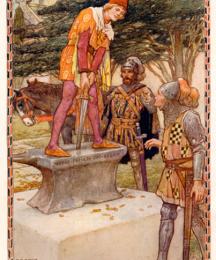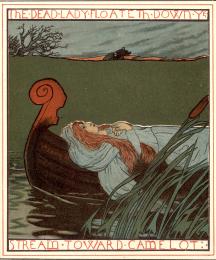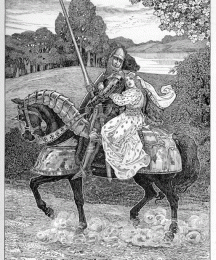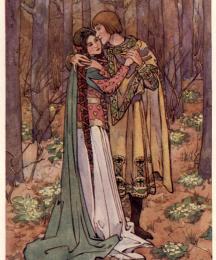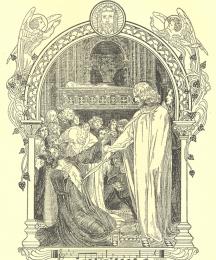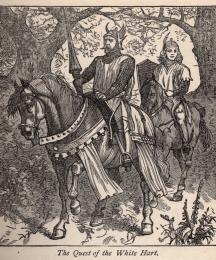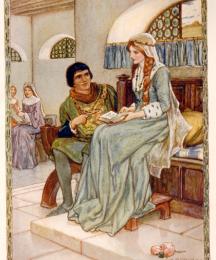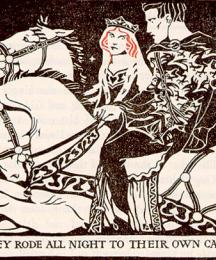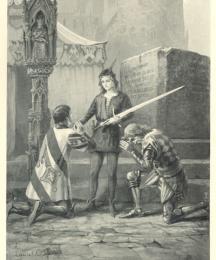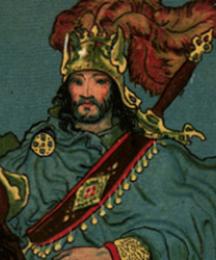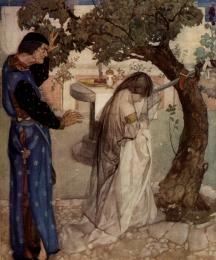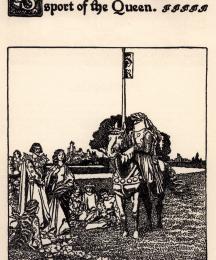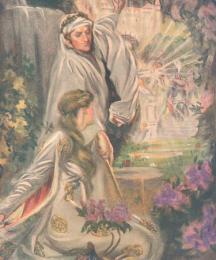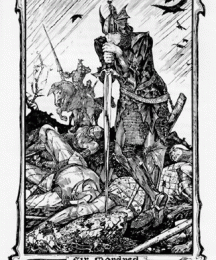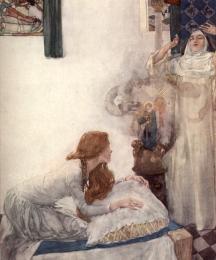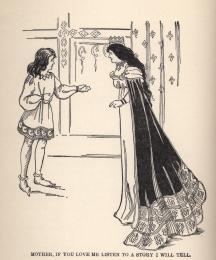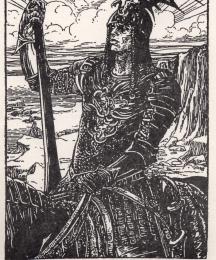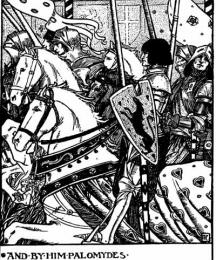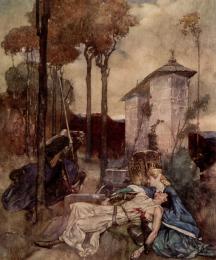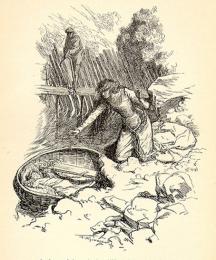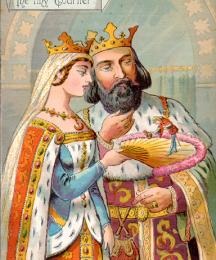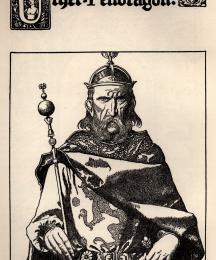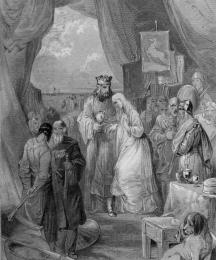Agravaine is the son of Lot and Morgause and the brother of Gawain. In the Vulgate Lancelot, Agravaine is said to be arrogant and jealous and ready to speak evil words. Although he shows no pity or love, he is a bold knight. In the Vulgate Mort Artu, he tells Arthur that Lancelot loves Guinevere and then traps the lovers in the queen’s room...
King Arthur is the figure at the heart of the Arthurian legends. He is said to be the son of Uther Pendragon and Ygraine of Cornwall. Arthur is a near mythic figure in Celtic stories such as Culhwch and Olwen. In early Latin chronicles he is presented as a military leader, the dux bellorum. In later romance he is presented as a king and emperor....
The story of Balin is recounted in the Old French Suite du Merlin and in Malory's Morte d'Arthur. Balin and Balan are the tragic brothers who, despite their nobility, wind up killing each other. Balin in particular seems cursed by fate. For example, when he offers protection to a knight, he is unable to foresee--or even see--the danger...
Table of Contents
Introduction
Welsh literature and the early chronicle tradition
Twelfth and Thirteenth Century Romance
Fourteenth-Century Romance and Malory
Tennyson’s Idylls of the King
Modern Fiction, Part 1: Bedivere as Storyteller
Modern Fiction, Part 2: Bedivere in Non-Traditional Roles...
Bors is an important character in the Vulgate Cycle and in Malory’s Morte d’Arthur (which does not include the early adventures of Bors but does tell, in an account similar to that in the Vulgate, of Bors’ part in the Grail quest and in the events leading to the fall of Camelot. Bors is the son of King Bors of Gaunes and the...
Dagonet, most simply, is King Arthur’s court fool. Also called Daguenet, and often carrying an epithetical surname such as “the Fool” or “the Coward,” the character is perhaps most interesting in that he did not begin his fictional existence as a fool at all. Enid Welsford’s 1935 book, The Fool: His...
Dinadan comes to prominence in the 13th century in the French Prose Tristan, where he is a foil to those knights who unquestioningly accept the assumptions of chivalry and courtly love. In the 14th-century Italian Tavola Ritonda, Dindano is the cousin of Breus sanz Pietà. He comments on the folly of love but becomes devoted to Tristano....
Elaine of Astolat, a character closely related to the Lady of Shalott, is an innocent maiden who falls deeply in love with Sir Lancelot. When he does not return her love, she dies of grief and floats in a barge down the river to Camelot. Elaine’s story is found in important works of literature by authors such as Malory and Tennyson, and she is...
Elaine is the daughter of King Pelles and the mother of Galahad. (The Vulgate Cycle says “she was called Amite though her true name was Helizabel.”) Because she was considered the fairest lady in that country, Elaine was put into a tub of boiling water by Morgan le Fay and the Queen of Northgales and could be freed only by the best...
Enid and Geraint are the principle figures in the Welsh tale of Geraint the Son of Erbin, to use Lady Charlotte Guest's title, or Geraint and Enid, one of three Welsh stories analogous to romances by Chrétien de Troyes (the others being Owain and Peredur). Chrétien's Erec et Enide, written c. 1170, is his earliest extant...
The "Fair Unknown" is a universally popular folk motif with strong Arthurian connections in which a young man of questionable lineage becomes an integral part of society. Initially appearing in court without an established identity, the Fair Unknown nevertheless boldly demands to be knighted. He tends to be markedly — albeit...
The mysterious Fisher King is a character of the Arthurian tradition, and his story may sound familiar: suffering from wounds, the Fisher King depends for his healing on the successful completion of the hero's task. There are many different versions of the story of the Fisher King, and the character is not represented uniformly in every text....
Gaheris is one of Gawain’s brothers, a son of Lot and Morgause. According to the Post-Vulgate Cycle and Malory, Gaheris kills his mother when he finds her in bed with Lamorak. (In T. H. White’s The Once and Future King, it is Agravaine, not Gaheris, who kills his mother.) Gaheris, along with his brother Gareth, is ordered by...
Sir Galahad, the son of Lancelot and Elaine of Corbenic, is best known as the knight who achieves the Holy Grail. When Galahad appears, he is the chief Grail knight; in the French and English traditions, he replaces Perceval in this role. Galahad first appears in the thirteenth-century Vulgate Cycle. The opening part of the Cycle, the Estoire del...
Gareth is the youngest brother of Sir Gawain and the son of Lot and Morgause of Orkney. He plays a significant role in Malory's Morte d'Arthur. Malory's "Tale of Sir Gareth" was apparently created by Malory. It presents Gareth as an exemplar of chivalry who is knighted by and devoted to Sir Lancelot and who acts chivalrously...
Gawain, usually the son of King Lot of Orkney and Arthur's sister Morgause, is one of the most pervasive figures of the Arthurian tradition. He appears in nearly all of the major Arthurian stories, medieval and modern, and plays a central role in many. There are, in fact, more medieval romances devoted to Gawain's exploits than to those of any...
Guinevere is said to be the daughter of Leodegrance of Cameliard in late medieval romance. In many sources, she marries Arthur and then has a love affair with Lancelot which causes the downfall of Camelot.
The Welsh Triads speak of "Arthur's Three Great Queens," all named Gwenhwyfar (Triad 56) and name Gwenhwyfar as "more...
Igraine is the wife of Uther Pendragon and the mother of Arthur. Uther falls in love with her when she is married to the Duke of Cornwall, who in some sources is named Gorlois. Uther’s attention to Igraine causes a rift between him and her husband, who secures her in his impregnable castle at Tintagel. Enlisted by Uther to help satisfy his...
One of the most frequently represented characters in Arthurian literature, Kay has never starred in his own romance. He is not a heroic figure: constantly presented as a hot-tempered, sharp-tongued fellow, he is generally abusive to those whom he perceives as weaker than himself. In romances, Kay is tolerated by the rest of the Round Table because...
The Lady of the Lake is an especially ambiguous and shifting character in the Arthurian legends. She accordingly goes by several other names, most of which are variations on Nimue or Vivianne, the latter derived from a Celtic water-goddess. In her initial appearances, however, she is nameless: in the Old French Le Chevalier de la...
In Chrétien’s Erec (ca. 1165), Lancelot is said to be the third best knight after Gawain and Erec, but in Chrétien’s Lancelot (1179-1180), Lancelot becomes the central figure and the lover of Guinevere who is willing to take any risk or to suffer any indignity in service of the queen. According to both Chrétien and...
Lanval or Launfal, while not one of the famous knights like Lancelot, Gawain, Tristan, and Perceval, who dominate medieval romance, was nevertheless internationally known. In the latter half of the twelfth century, Marie de France wrote a Breton lay called Lanval. Breton lay is a term that designates a short verse tale claiming to be based on a...
Mark is King of Cornwall and as brother of Tristan's mother (named Elyzabeth in Malory; Blanscheflur in Gottfried; Blauncheflour in Sir Tristrem) he is Tristan's uncle. Mark appears in early Celtic literature such as the Triad telling the story of Tristan as one of the three powerful swineherds of Britain. In this Triad, "Drystan son...
Meleagant (or Melyag(r)aunce or Melwas) is best known as the wicked knight who abducts Guinevere and is ultimately slain by Lancelot. The earliest form of the name, Melwas, has been interpreted as meaning "prince of death" or "princely youth." The classic account of the abduction story is in Chrétien de Troyes's...
Merlin, Arthur's adviser, prophet and magician, is basically the creation of Geoffrey of Monmouth, who in his twelfth-century History of the Kings of Britain combined the Welsh traditions about a bard and prophet named Myrddin with the story that the ninth-century chronicler Nennius tells about Ambrosius (that he had no human father and that...
Mordred (Modred, Medrawd, or Medraut) has become the quintessential traitorous villain in the Arthurian tradition. According to the majority of texts, he is Arthur's bastard son by his half-sister Morgause, the wife of King Lot. This incestuous begetting, alternately an innocent mistake on the part of both parties, as the French Vulgate...
Like many characters in the Arthurian legends, Morgan le Fay has been consistently transformed and interpreted by authors and artists for nearly a millennium. Her character and her narrative significance have varied widely from text to text, and while no easy description of these changes can be made, some general trends and developments can...
Although Morgause remains, even in many modern Arthurian texts, a relatively minor character compared with women like Guinevere and Morgan le Fay, her small role is a crucial one. According to Thomas Malory, she is one of the three daughters of Igrayne and the Duke of Cornwall, half-sister to Arthur, and later, the wife of King Lot of Orkney and...
Moriaen, a black Christian knight from the Land of Moors and Percival’s nephew, appears in the Dutch Roman van Moriaen written in the 13th centaury. The unknown author provides a few metatextual claims such as that a scribe neglected this story when copying the Roman van Lanceloet and that another version exists where Moriaen was Percival’s son...
Sir Palamedes (var. Palomedes, Palomides, Palamede, and Palomydes) is a minor figure within the literary Arthurian tradition. Palomedes first appears in the 13th century. He is a Saracen knight of the Round Table; unbaptised and thus technically a pagan, but a true Christian at heart; a courtly lover who never achieves his desires; a figure of...
In Malory’s Morte d’Arthur, Pelleas is a knight who loves Ettarde. After he wins a tournament and declares her the fairest woman, she scorns him. Just so he can see her, Pelleas lets himself be taken prisoner by her knights even though he has defeated them. Gawain offers to help Pelleas by pretending to have killed him and thereby,...
In the Post-Vulgate Queste del Saint Graal, Pellinore is said to follow the Questing Beast and to be the father of Aglovale, Lamorak, Perceval, Perceval’s sister, and other children. The thirteenth-century Vulgate Merlin says that he is the Maimed King and the brother of Alan the Fisher King and of Pelles. He is also, according to Malory,...
OVERVIEW
Perceval is a central figure in medieval and modern accounts of the quest for the Holy Grail. Depending on the version, Perceval serves either as the sole Grail knight or as one of a select few worthy knights. As Perceval’s variable presence suggests, the Grail legend itself underwent many changes as it spread across Europe because in...
In the Vulgate Queste del Saint Graal, Perceval’s Sister leads Galahad to Solomon’s ship. From her own hair and from gold and silk, she makes a belt for the sword that Solomon left for Galahad. After agreeing to give her blood to cure a leprous woman even though she knows she will die as a result, Perceval’s sister asks to be...
Taliesin "of the shining brow" is a mytho-historical character generally associated with early Wales and North Western Britain in the 6th century AD. He is a figure belonging to both history, as an important Old Welsh court poet, and to mythology, as a magician and seer in both Celtic and Arthurian legend. The fictive and quasi-fictive...
The legend of Tom Thumb began as a folktale of unknown ancient origins that is almost certainly based on an oral tradition. The novelty of Tom's adventures has clearly captured the imagination of people throughout the ages and across cultures, as demonstrated by the multicultural versions, as well as English adaptations to the tale. A...
Tristan and Isolt's conflict of love and loyalty is one of the classic tales of Western literature; in the Arthurian tradition, their tragic tragectory rivals and complements that of Lancelot and Guinevere. The basic story is one of mis-directed love: Tristan, the heroic nephew of King Mark of Cornwall, is sent to Ireland to escort the Irish...
Uther is the brother of Aurelius Ambrosius and Constans and the father of Arthur. Geoffrey of Monmouth explains that Uther is called Uther Pendragon because of a comet in the shape of a dragon that appeared in the sky before a battle with the Saxons in which his brother Aurelius dies. The dragon is a sign of Aurelius’s death and Uther’...
Vivien, sometimes called Nineve, Nimue, Niniane, etc., is best known as the woman who seals Merlin in a cave or a tree. Despite foreseeing his fate, Merlin is unable to prevent being captivated and captured by the woman Richard Wilbur has called "a creature to bewitch a sorcerer." Vivien is an ambiguous character. In Malory, for example...
Gildas refers to a "superbus tyrannus" (proud ruler) who invites the Saxons into Britain. Bede names this figure Vortigern. Nennius tells of Vortigern's attempt to build a tower which will not stand. He is advised to sprinkle the site with the blood of a child with no father. The child—Ambrosius in Nennius's account and...
Yvain is the cousin of Gawain and the son of Morgan le Fay and Uriens. As Owain, he appears in the Welsh tale of The Dream of Rhonabwy and is the hero of the Welsh analogue to Chrétien de Troye's Yvain or the Knight of the Lion. Both Chrétien's tale and the Welsh Owain tell the story of Yvain's (or Owain's) adventures...




